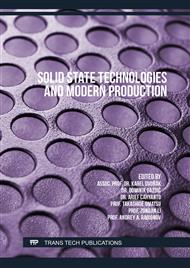p.3
p.11
p.19
p.27
p.35
p.45
p.55
p.65
Influence of Styrene-Ethylene-Butylene-Styrene and Stearic Acid on Poly(Lactic) Acid/Alumina Filament Composite for Fused Deposition Modeling Application
Abstract:
This study investigated the influence of adding styrene-ethylene-butylene-styrene (SEBS) and stearic acid (SA) on poly (lactic) acid (PLA) with nano-alumina (Al2O3) filament composite for fused deposition modeling (FDM) 3D printing (3DP) application. The filament composites were produced via hot-melt extrusion using a twin-screw extruder. Materials characterization and mechanical testing were conducted to determine the effect of SEBS+SA. Fourier transform infrared spectroscopy (FTIR) illustrated the interaction of the aliphatic group of PLA and SEBS+SA. XRD data showed that the SEBS+SA has no significant effect on crystallinity, but the differential scanning calorimetry (DSC) data showed a decreasing trend. Due to the nature of SEBS+SA, the heat capacity increased to 1.222 J/g•C°. The cold crystallization, melting, and degradation temperatures were reduced by 18.34°C, 5.29°C, and 25.19°C, respectively. An increase in the developed filament composite’s processability was evident in the MFR data. The axial strain and the toughness of PLA with nanoAl2O3 were increased significantly by 402.54% and 48.20%, respectively. Furthermore, the SEM images revealed overlapping of intra-and interlayers of the 3D printed specimens.
Info:
Periodical:
Pages:
3-10
Citation:
Online since:
October 2022
Authors:
Price:
Сopyright:
© 2022 Trans Tech Publications Ltd. All Rights Reserved
Share:
Citation:



